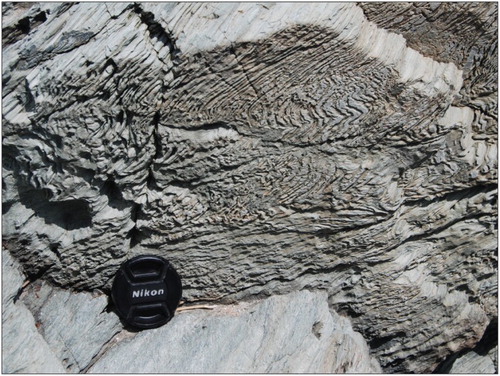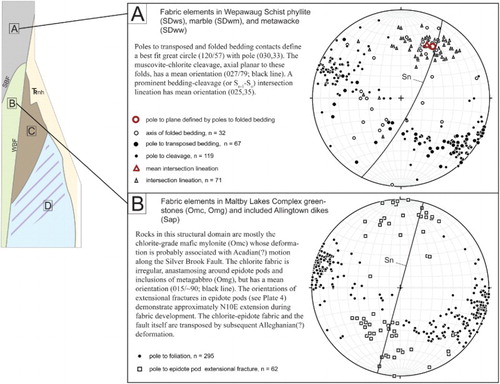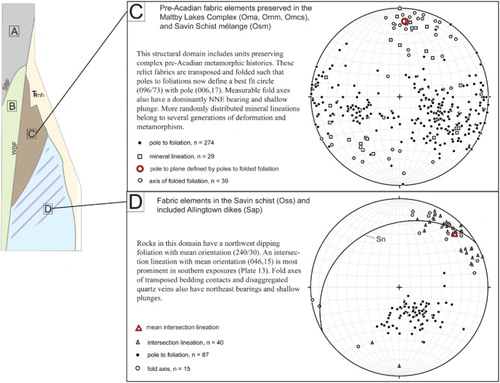Figures & data
Figure 2. Orientations of brittle structures. The map area is subdivided into six brittle domains A–F. Some of the structural domain boundaries are themselves faults: The Silver Brook Fault (SBF), Bishop’s Pond Fault (BPF), and the Western Border Fault (WBF). Structural domain boundaries not labeled as faults are lithologic contacts. Windrose diagrams showing the orientations of through-going joints in each structural domain were generated with WindRose for Matlab (CitationPereira, 2015).
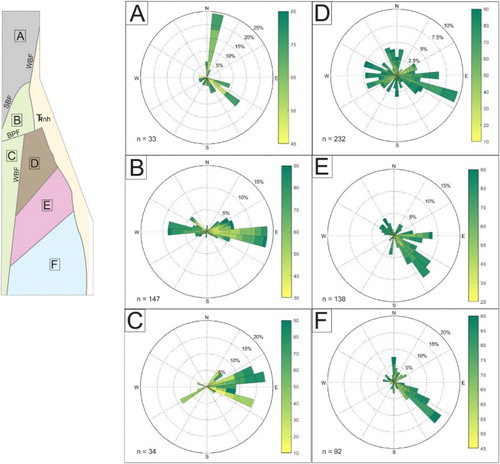
Plate 1. Triassic nonconformity. Where this surface is exposed in New Haven quadrangle, the basal conglomerate (nh) overlies epidote-pod, chlorite schist (Omc). In this northwest-facing image, the nonconformable surface (dashed line) has an eastward dip (hammer for scale). The inset stereonet shows poles to the nonconformable surface (yellow circles, n = 23). The surface, though irregular, has a mean orientation of ∼010/35 (dashed line). The exposure of this nonconformity has the same orientation as the contemporaneous surface exposed in Roaring Brook (gray circles, n = 4).

Plate 2. Multiple fabrics in the Wepawaug phyllite (SDws). In this north-facing photograph psammitic bedding (So) isasymmetrically folded. The axial planes (AP, dashed lines) of these folds are subparallel to the dominant muscovite-chlorite cleavage in adjacent phyllitic layers (Sn). The orientation of cleavage refraction between psammitic and phyllitic layers suggest dextral shear during fabric formation (arrows). In the right-hand side of the image, this fabric is sharply truncated by another muscovite-chlorite fabric (Sn + 1) that contains weakly boudinaged quartz veins.

Plate 3. Deformed Wepawaug phyllite (SDws) near Silver Brook Fault. In this north-facing image quartz veins are variably folded and attenuated into the mylonitic Sn + 1 muscovite-chlorite fabric (see ). in the footwall of the Silver Brook Fault. Lens cap is 53 mm in diameter.
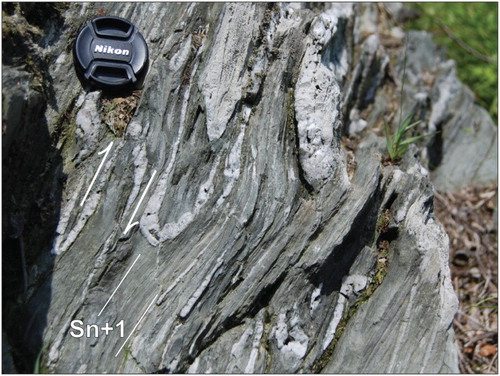
Plate 4. Allingtown dike (Sap) cutting Maltby Lakes Complex mylonite (Omm). The epidote-amphibole fabric in the mylonite (Omm) is truncated (dashed line) by a deformed porphyritic dike (Sap). Later deformation has transposed the contact, crenulated the mylonite, and given the porphyry a weak foliation, roughly parallel to the axial plane of folds in the mylonite. Field of view is approximately 20 cm.
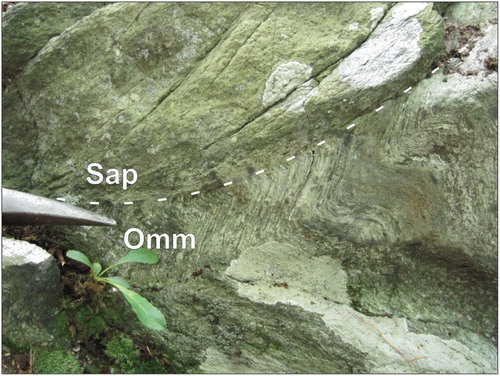
Plate 5. Sheeted dikes of the Allingtown dike swarm (Sap). One of many intrusive contacts (dashed line) exposed within the main body of the Allingtown dike swarm (Sap). Inset stereogram shows poles to undeformed contacts of newer Sap dikes intruding older Sap dikes. Half dikes and dikes with two chill margins are both exposed. Half dikes do not show systematic opening direction. Contacts with eastward-coarsening porphyry (hollow circles, n = 10) are slightly more abundant than westward-coarsening contacts (filled circles, n = 8).
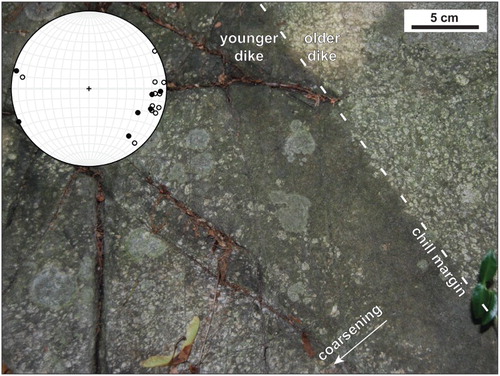
Plate 6. Allingtown dike (Sap) cutting the Savin Schist (Oss). The weakly foliated dike truncates (dashed line) a coarse-grained muscovite-chlorite-quartz metamorphic fabric in the schist (Sn-1, dotted line). Later deformation has folded and refoliated the schist (Sn, solid lines) and penetratively chloritized the dike.

Plate 7. Epidote-pod chlorite schist and mylonite (Omc). Fine-grained aggregates of epidote (Ep) form boudins in a fine-grained chlorite fabric. Low-weathering extensional fractures (dashed lines) in epidote pods are filled with carbonate or, uncommonly, asbestiform amphibole. The epidote pods are thought to have originated as veins, disaggregated by shearing. Also present in this image are coarse-grained, subspherical epidote porphyroblast aggregates (arrows).
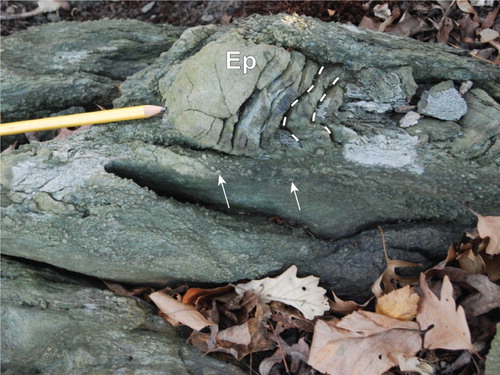
Plate 8. Metagabbroic inclusions (Omg) in chlorite mylonite (Omc). The chlorite schist (Omc) includes 0.01–5 m inclusions of a massive, coarse-grained metaggabro (Omg) containing saussuritied plagioclase and uralitized clinopyroxene. Lens cap is 53 mm in diameter.
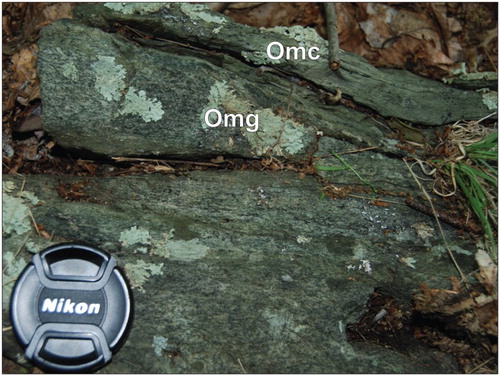
Plate 9. Epidote-amphibole gneiss (Oma) and mylonite (Omm). The Maltby Lakes Complex preserves lozenges of amphibolite facies, prograde mafic gneiss (Oma), and mylonite (Omm). The image above shows the partial replacement of the gneissic actinolite-plagioclase texture by the epidote-actinolitic hornblende mylonite.
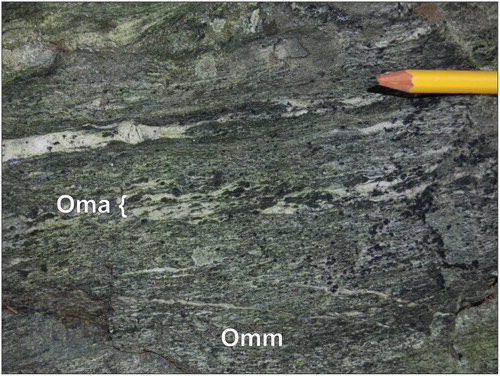
Plate 10. Allingtown dike (Sap) cutting coarse-grained fabric in mafic gneiss (Oma). In this image a massive porphyritic dike (Sap) cuts the strongly lineated gneiss (Oma) at a high angle (dashed line). This locality was apparently untouched by later deformation that elsewhere folded units of the Maltby Lakes Complex and foliated the Allingtown dikes (e.g. ).
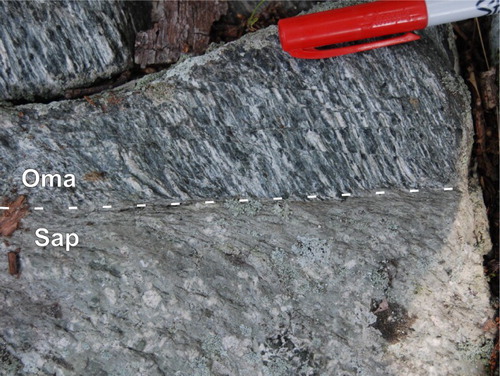
Plate 11. Calcitic serpentinite (Omcs). This cut surface exposes the mélange texture of this unit, with subangular-to-round, massive-to-foliated clasts of serpentinite (S) in a foliated serpentine, calcite, and magnetite matrix. The foliation runs parallel to that of the dominant foliation in the adjacent micaceous mélange (Osm, ).
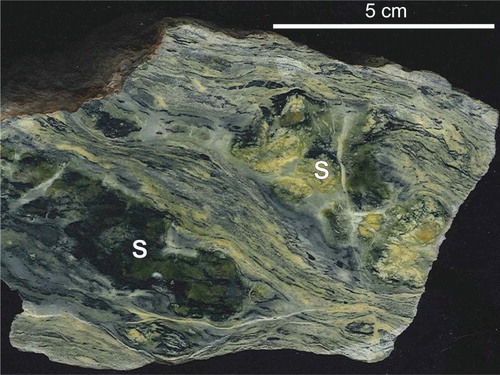
Plate 12. Savin Schist micaceous mélange (Osm). This unit is characterized by the presence of angular clasts of fine-grained chlorite schist (C) in a coarse-grained, foliated muscovite-chlorite matrix. Folded ribbons of disaggregated quartz veins are also characteristic. The dominant fabric, subvertical in this image, is truncated by intrusions of the Allingtown dike swarm.
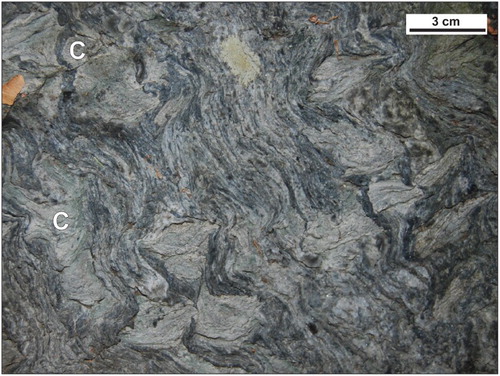
Plate 13. Savin Schist (Oss) at Savin Rock. This northeast-facing image shows the older fabric (Sn-1, ) refolded by the northwest-dipping schistosity (Sn) in this chlorite-muscovite-quartz mylonite.
